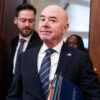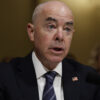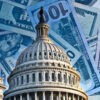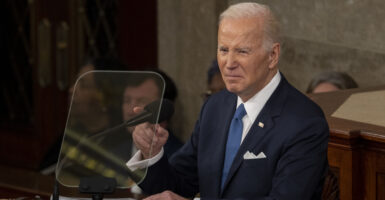President Joe Biden delivered his second State of the Union address Tuesday night. (His address in 2021 was to a joint session of Congress but not a true State of the Union speech because he had just taken office, although that’s a distinction likely lost on audiences outside Washington.)
Meanwhile, RealClearPolitics co-founder and President Tom Bevan and Real Clear’s Washington bureau chief, Carl Cannon, on Tuesday debated whether the State of the Union address has devolved into little more than political theater that we all could do without.
Regardless, Biden delivered a 72-minute speech, and The Heritage Foundation’s policy experts and researchers weighed in with their reactions to it and with analyses of the president’s many claims and proposals. (The Daily Signal is the news outlet of The Heritage Foundation.)
Introduced in the House chamber at 9:04 p.m. EST, Biden began speaking at 9:10 p.m. The speech concluded at 10:22 p.m.
The commentary and analysis on the speech from Heritage experts, aggregated here, was updated throughout the evening and the following morning.
>>>ECONOMY, TAXES, SPENDING
‘Economic Plan Is Breaking Records.’
(But Not in Good Way)
President Joe Biden on Tuesday, in a tweet ahead of his State of the Union address, claimed his “economic plan is breaking records.”
He’s right.
- Revolving debt is exploding as consumers wipe out savings to pay living expenses. Revolving debt is nearing $1 trillion, an increase of more than $200 billion since Biden’s first such address two years ago. For a family of four, that represents $2,400+ in additional debt.
- The personal savings rate is near all-time lows of below 3%. The hottest inflation in more than 40 years has dwarfed the growth in income. Real average hourly earnings year-over-year fell for the 21st consecutive month in January. That’s an unmatched disaster.
- Median inflation-adjusted weekly earnings dropped by 4.7% during Biden’s first two years—the biggest two-year plunge in more than 40 years. For a typical dual-income, married couple earning $60,000 each in 2020, inflation outpacing wage gains has eroded more than $5,600 in their standard of living.
- Indeed, in 2022, real disposable personal income dropped by a record 6.2%—the largest in history and for just the fourth time in the past 60 years.
- Looking to buy a home? It’s never been this unaffordable. The total median monthly payment on a home (mortgage principal and interest payments, taxes, and insurance) is more than $2,550 today versus under $1,600 when Biden took office—a payment hike of nearly $11,500 a year for a typical home.
- On the jobs front, too, historic weakness abounds. Labor-force participation (percentage of the population age 16+ working or looking for work) is at just 62.4%—1.1 percentage points below the February 2020 levels. That represents more than 2.9 million people who have dropped out of the labor force. The number of full-time jobs dropped by 166,000 since May—or more than 4,700 each week on average—even as the number of total jobs increased. That suggests that more people are working multiple jobs to cover the soaring cost of living.
The Biden economic plan is indeed setting records—just not the records any president should be proud of attaining, and families are suffering as a result.
—Joel Griffith, research fellow in financial regulations with Heritage’s Thomas A. Roe Institute for Economic Policy Studies
Claim of Record Deficit Cutting Is Bogus
In President Joe Biden’s speech full of whoppers, perhaps the most egregious was his claim that “my administration cut the deficit by more than $1.7 trillion—the largest deficit reduction in American history.”
To use the president’s favorite insult, that’s “malarkey.”
The deficit was going to decline in 2021, regardless of the outcome of the 2020 election. Even a ham sandwich occupying the Oval Office would have overseen record deficit reduction. That was due to the astonishingly high deficits in 2020 caused by a series of reckless, multitrillion-dollar spending bills enacted in the name of the pandemic.
What really matters are the choices Biden made once in office.
As he laid out in excruciating detail at the start of his speech, he has repeatedly chosen to add to deficits by supporting one spending increase after another—at the expense of American families.
Last year, the Congressional Budget Office estimated that Biden’s myopic choices added $2.77 trillion to near-term deficits. An updated budget outlook expected later this month will almost certainly see that dreadful number grow.
Incredibly, things would have been even worse if Biden’s disastrous “Build Back Better” plan had passed as he originally envisioned. That failure is the closest Biden has come to improving federal finances.
The State of the Union speech shows that Biden still views government as the source of prosperity, and that he believes the only solution to unsustainable debt and deficits is draining even more money from the economy (despite record-shattering tax revenue).
Fortunately, the new Congress has an opportunity to reverse course by following The Heritage Foundation’s Budget Blueprint. The plan would eliminate wasteful spending and harmful bureaucracies, reduce inflationary pressures, put the federal government on a path to a balanced budget, and save Social Security and Medicare from looming bankruptcy.
The core of Biden’s rusted agenda—more taxing and spending—is the last thing America needs.
—David Ditch, policy analyst specializing in budget and transportation policy with Heritage’s Grover M. Hermann Center for the Federal Budget
Contrary to Biden’s Claims, New IRS Agent Army Puts Middle Class, Small Businesses at Risk
In his State of the Union address Tuesday night, President Joe Biden claimed, “Instead of cutting the number of audits of wealthy taxpayers, I signed a law that will reduce the deficit by $114 billion by cracking down on wealthy tax cheats.”
This was in reference to legislation signed into law last year hiring up to 87,000 new Internal Revenue Service agents. Biden’s statement plays off a directive by Treasury Secretary Janet Yellen promising to avoid an increase in audit levels for households earning less than $400,000 “relative to recent years” and demanding that “any additional resources” given to the IRS should not be used to increase those audit levels.
A “directive” does not hold the force of law. As such, it’s cold comfort to law-abiding middle-class families who cannot afford the rigors of an IRS audit. But even taking Yellen at her word, families and businesses have good reason to be concerned.
That’s because many businesses with just a few employees take in more than $400,000—even if only a slim profit results due to tight margins. For small businesses across the board, those with just six employees typically see annual profits near $400,000.
Those tiny businesses are hardly the “large corporations” to which Yellen referred in her directive. Nor are their owners likely to be the “high net-worth individuals” to which she also referred. But these small businesses and the middle-class families who depend on them are nevertheless likely to be swept up in the coming audit crusade.
An audit can portend bankruptcy, emptied checking accounts, a freeze on assets, hundreds of hours of time responding, and tens of thousands of dollars in legal and accounting fees. That’s true even if you have been paying all taxes owed and even if the IRS concludes you don’t owe more.
Notwithstanding the president’s assurances, middle-class families and small businesses may be in for a big tax shakedown.
—Joel Griffith, research fellow in financial regulations with Heritage’s Thomas A. Roe Institute for Economic Policy Studies
Huge Subsidies for Favored Green Energy Companies That Pay Least in Taxes
The president claimed that 55 of the largest corporations paid no federal income taxes in 2020, and he touted the newly enacted corporate minimum tax that he said would ensure big corporations pay their “fair share.”
This talking point may score political points, but the legislation Biden signed last August was, in fact, a massive giveaway to the very corporations that pay the least in taxes; namely, green energy companies.
There are valid reasons why some profitable companies may not pay federal income taxes in a specific year, including timing differences between when income or expenses are recorded for tax purposes versus when they’re recorded on financial statements.
Over the course of a few years, many of these discrepancies work themselves out so that a company’s low tax rate in one year is offset by a higher tax rate in another.
Even the study that Biden references shows that most of the 55 companies paid some federal income taxes over the three-year period of 2018 to 2020.
The handful of companies that do manage to avoid paying income taxes year after year do so by claiming generous tax credits to offset their taxes. And because the tax code offers the most generous tax credits for green energy, companies in that one small sector of the economy account for most of the large companies that consistently pay no income taxes.
That was true even before the previous Congress and the Biden administration handed out another quarter-trillion dollars of new green tax credits.
Because Biden and Congress tripled down on green tax subsidies in last year’s big tax-and-spend bill, the unlevel playing field just got a lot steeper.
The corporate minimum tax won’t have much effect on green energy companies.
First, companies will be allowed to use tax credits to offset more than 75% of their tax liability, largely defeating the purpose of a minimum tax.
More egregiously, Biden’s and Congress’ legislation allows companies to sell their green tax credits to other companies. Think of it as an escape valve that will allow green energy companies to keep benefiting from tax credits even after they’ve stockpiled enough credits to offset all the federal income taxes they could anticipate having in the foreseeable future.
Biden’s minimum tax is almost bottomless for his favored green energy allies, who will pay negative taxes.
—Preston Brashers, senior policy analyst for tax policy with Heritage’s Grover M. Hermann Center for the Federal Budget
In His Mind, Economy Exists for President’s Ego, Rather Than for Your Family
It’s clear that the president views the economy as having one true purpose; namely, to let him take credit for the work of others.
After more than two years of liberal politicians imposing COVID-19 lockdowns and economy-crushing regulation after regulation, he had the audacity to claim credit for recovery efforts.
In truth, economic growth coming out of the pandemic is due solely to the work of Americans to claw back from the burdens of those lockdowns and onerous regulations.
With no remorse or understanding of these burdens, Biden offered a list of proposals to double down on new government-imposed burdens.
He offered new taxes and new deficit-expanding federal spending programs on liberal pet projects. In reality, those policies would have only one effect—to constrict and starve our economy into submission.
If we let Biden enact these policies, he’d finally get his wish of a socialistic economy controlled fully by his favorite Washington bureaucrats. In essence, what we heard in his speech, as we have heard from this president and his allies so often, is a dystopian vision of economics as a zero-sum game.
He championed the idea of taxing businesses and investors into the ground—a policy that would compound the inflation tax on every American family. Businesses can’t pay taxes, they can merely pass the burden around in the form of lower wages, higher consumer prices, or reduced investment in future jobs.
In fact, when Biden promotes taxation on investors, that’s exactly what he is calling for; namely, reduced investment in future jobs and economic growth. The “wealthy” aren’t sitting on piles of gold that can be easily redistributed. Their wealth is the businesses that employ Americans and produce needed goods and services.
Biden’s obsession with micromanaging every aspect of economic activity conveys his blatant lack of faith in the American people.
The kind of economic and job growth that provides for our well-being and frees us to pursue our dreams doesn’t come from government decrees and coercion. It comes from the steady efforts of American workers, entrepreneurs, and visionary innovators to build for their families and the future.
—Richard Stern, acting director of Heritage’s Grover M. Hermann Center for the Federal Budget
A Tax on Income Before It’s Earned Defies Logic
Proving once again that some bad ideas never die, President Joe Biden resurrected his 2021-2022 proposal for a tax on unrealized capital gains.
The unrealized capital gains tax would be assessed on the calculated year-to-year increase in the value of individuals’ stocks and certain other assets.
Typically, capital gains taxes only apply when an asset is sold or transferred and a taxpayer realizes income, but under Biden’s plan, the IRS could tax income before it’s earned.
This idea didn’t make sense the last time Biden proposed it. If anything, it makes less sense now.
Consider what would have happened if an unrealized capital gains tax had been in effect in 2021 and 2022.
In 2022, massive market losses wiped out Americans’ 2021 gains. The five most valuable companies in the U.S. dropped in value by an average of more than 40%.
But if Biden’s tax had been in effect in 2022, at the same time as trillions of dollars of wealth was being destroyed, investors would be paying taxes on the disappearing wealth that they thought they’d gained in 2021.
Biden’s tax—if it were to follow last year’s version—would be a 20% tax that would only directly apply to taxpayers with a net worth of more than $100 million.
The convoluted tax would provide job security only for some accountants and auditors who would have the difficult task of assessing the value of certain privately held assets with no readily available market price. For everyone else, this would have devastating consequences.
An ill-conceived tax on millionaires’ investments would cause the wealthy to invest less, to move their wealth out of businesses and into untaxable assets, and even encourage some to move overseas. The ripple waves of reduced capital investments would rock everyday Americans.
Less investment in U.S. businesses would mean fewer and lower-paying jobs. It would drive up interest rates, increasing the cost of obtaining a mortgage, a car loan, or a business loan. And it would stunt innovation and reduce Americans’ retirement wealth.
—Preston Brashers, senior policy analyst for tax policy with Heritage’s Grover M. Hermann Center for the Federal Budget
>>>CHILD CARE, FAMILY LEAVE
Employer-Provided Family-Leave Programs Are Better Option Than Feds’ Version
Families are the foundation of society, and it’s important that members of families be able to care for each other.
Paid family leave is a great thing. But where employer-provided policies can be flexible, responsive, accommodating, and typically more generous, one-size-fits-all government programs are rigid, burdensome, and impersonal.
And despite those programs’ intent, the unfortunate reality of government-paid family-leave programs across the globe is that they are regressive, redistributing resources from lower-income families to middle- and upper-income ones.
There are a number of reasons for that, including that lower-income earners are less likely to meet government programs’ eligibility criteria. Lower-income earners are also less likely to be aware of, and understand, the programs, and most can’t pay their bills with the partial benefits that government programs provide.
In California, for example, fewer than 4% of claims went to workers in the lowest-income bracket, while nearly 21% went to workers in the highest-income bracket.
Fortunately, access to employer-provided paid family-leave policies is on the rise, increasing by 77% over just the past five years. And many of those gains have come from companies such as Lowe’s, Starbucks, and Walmart that employ lower-wage workers.
Yet, a government program would crowd out expanding employer-provided programs and force people to go through bureaucratic government programs instead of working directly with their employers.
Moreover, the costs would shift from companies to taxpayers, and those costs would be large.
Moreover, government programs are costly. A Congressional Budget Office analysis of Democrats’ proposed Family and Medical Leave Insurance Act found that it would create yet another unfunded entitlement program, with costs exploding to 240% of the program’s revenues within just six years and necessitating about $700 a year in new taxes for the median household.
And that’s for a program that would cover only 42% of workers’ paid family leave needs.
America doesn’t need another unfunded middle-class entitlement program or another bureaucracy that comes between workers and their families’ needs.
Instead of implementing a one-size-fits-all federal program, policymakers should look to policies like the Working Families Flexibility Act, by enacting Universal Savings Accounts, and by removing costly and unnecessary regulations so that employers have more resources to provide paid family leave that’s better tailored to their businesses and to their employees’ needs.
—Rachel Greszler, senior research fellow for budget and entitlements with Heritage’s Grover M. Hermann Center for the Federal Budget
>>>ILLEGAL IMMIGRATION
President’s Shell Game on Open Borders, Mass Parole Isn’t Fooling Anyone
Despite America’s worst border crisis in history, President Joe Biden gave scant attention to this real national security, public safety, and humanitarian threat.
He mentioned his new border plan for nationals of Cuba, Haiti, Nicaragua, and Venezuela, and wrongly claimed that illegal immigration from those countries has already decreased 97%.
Biden and Homeland Security Secretary Alejandro Mayorkas are trying to deceive Americans with this shell game of a nationality mass parole program. Mayorkas has instructed future migrants from these countries to make appointments at a port of entry, using a Customs and Border Protection mobile app, and they will be paroled into the U.S. using this new “lawful” pathway, or be removed if they do not.
The numbers are not decreasing. Rather, they are merely shifting from between the ports of entry to the ports themselves, as instructed.
Instead of changing his open-border policies to secure the border, Biden demanded Congress pass his comprehensive immigration bill and give amnesty to millions who illegally came to our country.
The lure of a potential amnesty is one of the strongest pull factors resulting in more illegal immigration.
Biden gives lip service to “border security,” but his policies have resulted in the most unsecure border in our nation’s history.
—Lora Ries, director of Heritage’s Border Security and Immigration Center
President Has Failed to Stop Mexican Drug Traffickers From Killing Thousands
Fentanyl is the principal villain responsible for the nation’s drug overdoses and fatalities. It’s worse than cocaine or crack, worse than meth, worse than heroin. According to the Centers for Disease Control and Prevention, fentanyl is the deadliest drug in the United States.
In 2021, fentanyl was identified in 77% of adolescent overdose deaths. Overdoses involving illicit fentanyl is the leading cause of death for people from 18 to 45. Illicit fentanyl is a weapon of mass destruction.
And who is responsible?
China and Mexico. China manufactures the precursor chemicals necessary to produce fentanyl, while the Mexican drug cartels use those chemicals to manufacture fentanyl and smuggle it across the southern border.
Why can they smuggle it across that border? Because the Biden administration has done nothing to stop the flow of drugs and people across the border from Mexico.
The president’s policies and actions have resulted in the expansion of the Mexican drug cartels’ operational control of the U.S. border because the president doesn’t want to let the Border Patrol do its job.
President Joe Biden said that we need to increase the penalties on illegal fentanyl trafficking. That’s not an answer. Life imprisonment is already an available penalty. We can’t increase that.
Biden said that we need more drug detection machines at the border. That’s not an answer. Drug detection machines cannot capture illegal smugglers because they don’t show up at border checkpoints with illegal drugs.
Biden said we need to work with couriers like Federal Express. That’s not an answer. Federal Express does not smuggle fentanyl across the border; the Mexican cartels do. Federal Express is not a law enforcement agency. Sadly, the Border Patrol doesn’t have that responsibility today because the president won’t let them do their job.
It’s a simple but critical question: President Biden, how many Americans must die before you stop fentanyl smuggling? Why won’t you answer that question? How many funerals, how many caskets, how many deaths are necessary before you will take the obvious step: Stop fentanyl smuggling from Mexico?
—Paul J. Larkin, senior legal research fellow with Heritage’s Meese Center for Legal and Judicial Studies
>>>HEALTH CARE
Call for Doubling Down on Obamacare Is Terrible Prescription for Your Health
President Joe Biden is touting the “success” of Obamacare and calling for its further expansion. Putting the government in charge of more of our health care decisions is a bad idea.
What started off as a temporary measure in response to COVID-19, the American Rescue Plan of 2021 made Obamacare subsidies more generous for those who were already receiving subsidies and made subsidies available to individuals who were previously not eligible (those earning above 400% of the federal poverty rate, or $106,000 for a family of four).
The Inflation Reduction Act of 2022 extended this arrangement until 2025. Now, the Biden administration wants to make those “temporary” subsidies permanent.
The administration points to “record-breaking” enrollment in Obamacare as a sign of success. Unfortunately, those numbers don’t tell the whole story. What the administration ignores is that Americans still have fewer choices today than before Obamacare was enacted, and premiums continue to soar.
Rather than addressing the factors contributing to these troubling trends, this administration wants to paper over these failures by throwing more money at the problem. Worse yet, the real winners under this scheme are the big Obamacare insurers, who will pocket the subsidies.
Biden also called out states who have rejected the Obamacare Medicaid expansion. Since taking office, this administration has done more to take away state flexibility than giving states the tools to accommodate the health care needs of the poor. Rather than pushing states to expand Medicaid, the states should be focused on moving people who do not qualify for Medicaid off the program and protecting the safety net for those for whom it is intended.
Biden’s calls for doubling down on Obamacare is just a means to expand government’s power and control over Americans’ health care. America needs to look no further than what is happening in the United Kingdom to see the damage government-run care does to your health.
The real solution is to give Americans—not the government—more control over their health care dollars and decisions.
—Nina Owcharenko Schaefer, director of Heritage’s Center for Health and Welfare Policy
Biden Should’ve Committed to Cooperating With Congressional COVID-19 Probes
President Joe Biden celebrated the end of the COVID-19 emergency. But it’s long overdue.
Since the surge of the omicron variant began to subside in early 2022, there has been a significant decline in previously high rates of hospitalizations and deaths from the coronavirus.
Death rates have declined in every age group except for those 75 years and older. Moreover, based on recent data, the death rate (again, except for the elderly) has remained steady at 1 in 100,000 since April 2022.
Last Aug. 11, the Centers for Disease Control and Prevention reported that high levels of vaccine and natural immunity have substantially reduced the risk of severe illness, hospitalization, and death. The CDC also stated that these changes enable public health authorities to reduce restrictions on social and economic activity.
The president should have followed this with a commitment that his administration will fully cooperate with congressional inquiries into the Chinese origins of COVID and holding public health officials accountable for their actions, including but not limited to anti-science masking mandates, vaccine mandates, or gain-of-function research. These decisions have caused permanent damage.
After three years and more than 1 million deaths, the country needs a comprehensive, sober, and detailed investigation into the federal government’s response. It is a necessary precondition for restoring Americans’ trust in federal public health agencies.
On Wednesday, the House Energy and Commerce Committee, under new leadership, is holding its first hearing on the federal response to COVID-19, at which Biden administration officials are expected to testify. Biden should welcome this bipartisan effort.
—Robert E. Moffit, a senior research fellow with Heritage’s Center for Health and Welfare Policy
Capping Insulin Prices Is Bad Medicine, Will Discourage R&D Investment
President Joe Biden’s call for capping insulin prices might sound good, but it misses the mark.
Data show that patients are paying more, while at the same time insulin manufacturers are being paid less. The difference can be found in the pockets of the middlemen. A better solution would be for Congress to clarify that those middlemen, particularly pharmacy benefit management companies, be treated as fiduciaries of their client health plans and obliged to act in the best interests of patients using insulin by passing on any savings.
Biden’s so-called achievement of Medicare prescription drug price “negotiation” is hollow. It forces drugmakers to either accept low government prices or face financial ruin. That’s like “negotiating” with a mugger holding a gun to your head.
Worse yet, it harms patients by discouraging investment in new drug development.
Furthermore, small biotech companies, not “big pharma,” are the main source of new treatments, and they rely on funding from venture capital investors willing to take big risks in exchange for possibly big rewards.
With these new price controls limiting the potential rewards of drug development, those funders will shift to investing in other sectors of the economy offering either lower risks or better rewards.
—Ed Haislmaier, Preston A. Wells Jr. senior research fellow with Heritage’s Center for Health and Welfare Policy
>>>EDUCATION
States, Not Federal Bureaucrats, Have Tools to Address Student Mental Health
The mental health of K-12 children after the pandemic is a very serious problem—and not one Washington can solve by meddling in local school affairs.
President Joe Biden’s comments Tuesday night suggest the federal government plans to send still more money to schools, this time to address mental health issues. “More money” is a regular response from education bureaucrats, and one that produces uninspiring results.
According to the Republican Policy Committee, schools are still holding on to most of the money that Washington sent during the COVID-19 pandemic.
Fully 85% ($130 billion) remains unspent of the nearly $200 billion that federal officials appropriated to schools over the past two years. And a new report from the Edunomics Lab at Georgetown University finds that schools are hiring more teachers—while serving fewer students.
None of this suggests that school officials need still more money for yet another federal program.
There’s a serious crisis in mental health among American youth. Hospital visits are up, and national associations such as the American Academy of Pediatrics and others declared a national emergency in 2021. State lawmakers can help by giving parents more flexibility with their child’s share of education spending.
School choice laws have passed already this year in Iowa and Utah, and additional proposals are under consideration in Oklahoma, South Carolina, Texas, and elsewhere.
Specifically, lawmakers are considering education savings account and account-style options that allow families to choose personal tutors, education therapists, private school tuition, textbooks, and more—all at once or in different combinations to meet their students’ unique needs.
State policymakers should add to these proposals and make sure parents can pay for counseling and therapy services, too, with their accounts.
Mental health needs are extremely personal and specific. Parents and family members are in the best position to help their children, while research has found that prior efforts by school officials to create “wrap-around” services have been unsuccessful at generating positive outcomes.
Other studies have found that parents who are using the accounts for their children in Arizona, Florida, and North Carolina do, in fact, choose multiple products and services simultaneously, and so, they are well-equipped to meet their children’s needs when empowered with these choices.
Families do not need Washington to send more taxpayer spending to assigned schools. Let’s empower parents with the ability to help their children with pressing mental health needs—not expand the K-12 bureaucracy.
—Jonathan Butcher, Will Skillman fellow in education with Heritage’s Center for Education Policy
Biden Wants You to Pay Off Loans for Someone Else’s Gender Studies Degree
President Joe Biden on Tuesday night bragged about his administration’s expensive, unfair, regressive, and unlawful attempt to provide massive student loan debt amnesty to college graduates, courtesy of the American taxpayer.
The administration’s most recent attempt to confer student loan “forgiveness” is through a backdoor rule that would change the parameters around “income-driven repayment,” such that 22% of four-year college graduates will never make a single payment on their loans.
As five former secretaries of education recently wrote in The Wall Street Journal: “It isn’t difficult to imagine the sweeping consequences of a precedent that allows a president to spend upward of a trillion dollars with the stroke of a pen. The floodgates of executive power would be opened in such a way that they could never be closed.”
Many individuals made a conscious decision not to attend college to avoid debt. Biden’s various debt-cancellation schemes foist someone else’s debt onto individuals who chose not to go to college, or who responsibly paid off their student loans. They should not be forced to pay off the loans of others.
What’s more,student loan debt cancellation will likely encourage colleges to raise tuition, particularly if graduates expect student loans to be forgiven again in the future. For their part, students are likely to attend a more expensive school and take out the maximum loan amount, confident their loans will be canceled going forward.
Loan forgiveness ultimately rewards the bad behavior of universities while punishing working Americans who didn’t want to—or couldn’t—attain a college degree. Since the 1991-92 academic year, total federal aid (including student loans and grants) increased 295%.
In response, colleges and universities more than doubled their tuition and fees in real terms.
Another federal student loan spending bonanza will also enable universities to continue funding a growing army of diversity, equity, and inclusion (DEI) officers and other administrative busybodies.
Debt amnesty is a handout to woke universities, plain and simple.Congress should stop the administration from pursuing student loan forgiveness in any form.
—Lindsey Burke, director of Heritage’s Center for Education Policy and Mark A. Kolokotrones fellow in Education
Large-Scale Federal Pre-K Subsidies Ineffective, Unwanted
Demand for new, large-scale government spending on early-childhood education and care is not evident, despite President Joe Biden’s call for the federal government to insinuate itself in funding preschool for 3- and 4-year-old children.
More than half of 3- and 4-year-olds already attend formal pre-K programs.
What’s more, according to Gallup, half of women who are employed and have children under age 18 would prefer to stay at home when their children are young. A 2021 survey from the Institute for Family Studies shows that 70% of mothers with a child under the age of 18 prefer child care to come from a parent or relative. And in that same survey, only 14% preferred a center-based child care provider.
Yet public preschool disproportionately subsidizes center-based providers that can afford to comply with costly regulations, while requiring parents who opt to stay home with their children to also carry the burden of subsidizing the child care costs of other families who use center-based care.
Moreover, the bulk of the scientifically rigorous evaluations of preschool programs yield consistently negative findings. Any benefits fade out over time.
Vanderbilt University evaluated Tennessee’s frequently cited “model” pre-K program for low-income children and found that the program failed to produce any sustained benefits for children. And the long-running federal Head Start program has had no long-term impact on the cognitive abilities of participating children, has failed to improve their access to health care, has failed to improve their behavior and emotional well-being, and has failed to improve the parenting practices of parents.
Instead of spending more federal taxpayer money on ineffective government preschool programs that run counter to what most families want in terms of child care, policymakers should focus on reducing regulations on early-childhood education and care providers to lower costs and allow more options to flourish.
—Lindsey Burke, director of Heritage’s Center for Education Policy and Mark A. Kolokotrones fellow in Education
>>>WELFARE
Child Tax Credit Scheme Wouldn’t Help Poor, but Only Expand Welfare State
President Joe Biden suggests resuming his child tax credit scheme, the cash payments from the IRS to parents that were in effect in the latter half of 2021.
The superficial value of this program is $3,000 per child per year ($250 times 12 months). But these payments replace the existing child tax credit, which has a value of $2,000 per child per year for most working-class and middle-class families.
For most families, every dollar in government cash is offset by 67 cents in higher income taxes.
Biden’s real goal is not to cut child poverty or to support the middle class, but to expand the welfare state. His plan would eliminate the current child tax credit work requirement and pay the full $3,000 per child to parents who simply choose not to work.
Under existing law, the child tax credit has a welfare component that sends cash grants to lower-income families with children that owe no income tax. But critically, these payments are linked to a work requirement. Families that perform no work in the year receive no cash. And, to encourage work and marriage, the cash payments start low and increase steadily as annual family earnings increase.
Middle-class and working-class families need good jobs, higher wages and lower inflation, not more government handouts. Lower-income families need a welfare system that encourages, not discourages, work and marriage.
The Biden plan fails on both counts.
—Jamie Bryan Hall, a research fellow in quantitative analysis at The Heritage Foundation
>>>CRIMINAL JUSTICE
Softness on Crime Only Sends Message That Lawlessness Will Be Tolerated
The Biden administration has completely abdicated its duty at the southern border, allowing human suffering and misery to flourish there and to spread throughout our country.
Rather than combating the resulting human smuggling, drug smuggling, and sex trafficking or the skyrocketing crime rates in major cities around the country, President Joe Biden has instead listened to the most radical elements of the Democratic Party, which he leads.
He has chosen to send a message that lawlessness will be tolerated. While he says that he opposes defunding the police, his actions say the opposite—and those actions align with many in his party who do call for defunding the police.
Why else, for example, would he have appointed Rachael Rollins, the former Suffolk County (Boston) district attorney who released a list of 15 crimes for which she wouldn’t prosecute someone, to be the U.S. attorney for the entire state of Massachusetts? We certainly don’t consider this action to “promote [the] effective prosecution of crimes affecting families today,” as the White House claims to do.
Biden also opposes congressional efforts to roll back Washington, D.C.’s new crime bill, which would drastically lower penalties for most offenses. It’s a bill so radical that even D.C.’s Democratic mayor, Muriel Bowser, opposed it.
Rather than politicizing the tragic death of a black man, Tyre Nichols, at the hands of five Memphis, Tennessee, police officers and implying that his death is a byproduct of a racist criminal justice system—even though everyone involved in the case is also black—Biden should be focused on helping communities by empowering federal law enforcement to prosecute more violent crimes and provide increased support to state and local partners.
Instead, he’s again calling for Congress to pass the deeply flawed George Floyd Justice in Policing Act, after issuing a flawed executive order attempting to accomplish many of the same goals by executive fiat.
The sad irony of increased violent crime—an irony that neither Biden nor anyone else on the left wants to talk about—is that young black men are disproportionately the victims of it. The very soft-on-crime policies that they counterintuitively claim help minority community members actually end up hurting them the most. And Biden ignored the fact that there is a homicide problem in blue cities, as we have written here.
If Biden is serious about helping minority members of our communities, he would back up his “not defunding the police” talk with actions to match.
Unfortunately, he hasn’t, and we doubt he will.
—Zack Smith and Cully Stimson: Smith is a legal fellow and manager of the Supreme Court and Appellate Advocacy Program with Heritage’s Edwin Meese III Center for Legal and Judicial Studies. Stimson is deputy director of the Meese Center, manager of Heritage’s National Security Law Program, senior legal fellow, and senior adviser to Heritage’s president
Biden Fires Wildly, Misses Target Again on Guns
The president told the nation that it’s time to “just do something” about gun violence.
He once again renewed his call to ban so-called assault weapons, which are nothing more than typical semiautomatic firearms with cosmetic features like pistol grips or barrel shrouds. He claimed that the 1994 federal ban caused mass shootings to decrease, and that after that law expired in 2004, mass shootings “tripled.”
Here’s the problem: Those claims simply aren’t true. There’s absolutely no compelling evidence that “assault weapons” bans affect the rate of mass public shootings, generally, or that the 1994 federal ban affected mass public shootings during that time period, specifically.
Moreover, the official government report on the 1994 federal assault weapons ban—which expired 10 years later—determined that “[s]hould it be renewed, the ban’s effects on gun violence are likely to be small at best and perhaps too small for reliable measurement. [Assault weapons] were rarely used in gun crimes even before the ban.”
More than 15 years later, rifles of any kind are still used in only 2% to 3% of annual homicide totals. Handguns, not rifles, are still by far the weapon most commonly used in mass public shootings.
Ironically, Biden’s calls for an assault weapons ban took place immediately after he praised the heroic actions of Brandon Tsay, an unarmed 26-year-old who courageously disarmed a gunman who had already killed 11 people at a dance studio in California.
California’s restrictive gun control laws—which include an “assault weapons” ban far more restrictive than the 1994 federal statute—did absolutely nothing to protect California residents from an act of horrific mass violence. At the same time, its restrictive laws on the public carrying of firearms essentially ensured that any person wishing to defend himself or herself would be unarmed.
Perhaps not surprisingly, Biden did not mention Elisjsha Dicken, a 22-year-old concealed-carry permit holder who fatally shot a gunman in a Greenwood, Indiana, mall last July.
—Amy Swearer, a legal fellow with Heritage’s Edwin Meese III Center for Legal and Judicial Studies
>>>SOCIAL ISSUES
Biden Embraces ‘Codifying’ Extremism on Abortion, LGBTQ Agenda
During his State of the Union address, the president urged Congress to “restore the right the Supreme Court took away last year” by “codifying” Roe v. Wade.
Biden seems to have forgotten, however, that the Supreme Court’s final word on the issue—its ruling in Dobbs v. Jackson Women’s Health Organization last summer—already clarified that the Constitution confers no right to abortion, and never did.
He characterized state abortion bans as “extreme,” and promised to veto a national abortion ban if passed by Congress—something unlikely to happen because Democrats maintained control of the Senate after 2022’s midterm elections. Achieving a consensus on a national ban of any kind will be practically impossible because of the Senate filibuster.
As he did in last year’s State of the Union address, the president once again called for passage of the “bipartisan” Equality Act to “ensure LGBTQ Americans, especially transgender young people, can live with safety and dignity.”
The Equality Act has stalled in Congress before, unable to get across the finish line owing perhaps in large part to the fact that it guts the Religious Freedom Restoration Act and religious protections for every American who won’t toe the liberal line on sexual orientation or gender identity.
Having witnessed the passage of the so-called Respect for Marriage Act, the White House is unsatisfied with its codification of the Supreme Court’s ruling in Obergefell v. Hodges on same-sex marriage, and instead wants to ensure that the definition of public accommodations is expanded and the definition of sex is expanded to include sexual orientation and gender identity, but wants the religious rights of Americans contracted.
If passed, the Equality Act would—far from eliminating discrimination against sexual minorities—ensure that religious Americans of all stripes find themselves in the crosshairs of a federal civil rights violation if they break ranks with the prevailing sexual orthodoxy.
—Sarah Parshall Perry and Thomas Jipping, senior legal fellows with Heritage’s Edwin Meese III Center for Legal and Judicial Studies
>>>ENERGY, CLIMATE CHANGE
Biden’s Finger-Pointing on High Energy Prices Should Be Done in Mirror
President Joe Biden continued blaming others for America’s energy woes in his State of the Union address.
For example, he blamed Russian President Vladimir Putin’s war in Ukraine for high energy prices. While it’s true that Putin’s invasion of Ukraine helped to push energy prices higher, the fact is gasoline prices had already begun rising in response to Biden’s anti-energy agenda soon after he took office more than a year earlier.
The numbers tell the story. The average price for a gallon of gasoline was $2.42 in January 2021, when Biden took office. By February 2022, when Putin invaded Ukraine, prices had already jumped up to $3.61. In subsequent months, prices did increase, but have since moderated.
Despite that, according to the U.S. Energy Information Administration, the average price for gasoline remains at a stubbornly high $3.45 per gallon. The story for diesel fuel is even worse, and perhaps more significant, as so much of America’s delivery and production infrastructure depends on diesel fuel.
The price for a gallon of diesel was $3.68 when Biden took office. Today, it remains at more than $4 per gallon. Of course, that’s exactly what we should have expected as Biden did everything that he could to slow down gas and oil production from Day One of his administration, starting with the closure of the Keystone XL Pipeline and slow-walking permits for new gas and oil development.
Later in his speech, Biden had the audacity to go after so-called “Big Oil” for recent reports of high profits and blamed higher prices on them with accusations of underinvesting in domestic production.
He ignored the fact that his policies to restrict supply is what is driving prices higher. Worse, he completely ignores the fact that he promised specifically to effectively run them out of business.
Given the massive, long-term investment necessary to increase production and refining capacity, why would the oil and gas industry make those investments in this business environment? Certainly, one could hardly blame them for not making those investments.
But the underinvestment accusation isn’t even true. While capital expenditures are off their 10-year highs, the U.S. gas and oil industry still spent $144.1 billion on capital expenditures in 2021, and those expenditures were expected to increase moving forward.
Biden might try to blame Putin and gas and oil producers for higher prices. But the numbers tell us that he only has himself to blame.
—Jack Spencer, senior research fellow for energy and environmental policy with Heritage’s Center for Energy, Climate, and Environment
Clueless President Wonders Why Oil, Gas Producers Are Hesitant to Invest
Reacting to stock buybacks in the U.S. oil and gas sector, President Joe Biden ad-libbed, “We’re going to need domestic oil for at least another decade.” The comment was met with scoffs from the audience, but it’s worth digging a little deeper to see why.
Notably, Biden’s remarks about Big Oil were not included in the written remarks circulated in advance by the White House. In a candid moment, Biden admitted that he hears the concerns of the domestic oil and gas industry; specifically, that “when I talk to a couple of them, they say ‘We’re afraid you’re going to shut down all the oil refineries anyway, so why should we invest in them?’ I say we’re going to need oil for at least another decade … .”
The reason for the scoffs is because this is a patently absurd view of a capital-intensive industry. Let’s say the leadership of America’s oil and gas companies decide today to invest in new exploration and production.
In the best-case scenario, new investments would not bring commodities to market for a few years (let’s say, five for sake of argument). Apparently, Biden finds it reasonable to ask oil and gas companies to invest heavily now to explore for and produce a commodity that he deems necessary for only a few more years.
Remember that Biden made a promise on the campaign trail to “end fossil fuels.” Some of us took that promise seriously, and we now wonder how the president can persuade fossil fuel producers—who enable modern living standards—to get back to the hard work of exploration and production when he has so clearly shown his intent to shut down their business in a matter of a few short years.
—Travis Fisher, a senior research fellow on energy and environment with Heritage’s Center for Energy, Climate, and Environment
Biden’s Minions Doing His Bidding to Curb Production of Oil, Natural Gas
In his State of the Union address, President Joe Biden accused oil companies of making record profits, and investing “too little of that profit to increase domestic production and keep gas prices down.”
When supply is constrained, prices rise. America has some of the largest reserves of oil and natural gas in the world, and companies want to produce it, refine it, and transport it to where it needs to go. If Biden were to approve additional production, instead of going to Saudi Arabia and Venezuela and asking them to produce oil, prices would decline.
A number of executive branch agencies, at Biden’s bidding, are slowing approval of production and transportation of oil and natural gas.
For instance, the Federal Energy Regulatory Commission issued a new policy last year that will make it even harder to put new pipelines in place to carry oil and gas from the interior of the country to the coasts, where it can be exported. FERC will now “consider a proposed project’s impacts on existing pipelines,” as well as the environmental effects of the new pipeline.
The Interior Department has issued a Report on the Federal Oil and Gas Leasing Program, calling for fewer leases, higher royalties from oil and gas leases, and a more thorough bidding process to screen buyers. It proposes that oil and gas drilling not be a priority, and its recommendations would make it more difficult to drill.
In the finance area, the Securities and Exchange Commission wants to regulate energy production. SEC Chairman Gary Gensler has proposed rules to require companies to disclose information about governance and management of climate-related risks; how climate-related risks will affect companies’ strategy and outlook; and the effects of climate events, such as hurricanes and wildfires on financial statements.
The Office of the Comptroller of the Currency, which regulates banks, has appointed a Chief Climate Risk Officer to assess and monitor climate-driven risks to banks. That will have the effect of discouraging investments in fossil fuels and allow the investigation of companies and banks that it thinks are making the wrong investments.
The Federal Trade Commission is considering investigating oil and gas companies for price gouging—even though people know that lower supply always leads to higher prices.
If Biden wants his administration to reduce oil and gas production and transportation, it’s natural that prices will rise.
—Diana Furchtgott-Roth, director of Heritage’s Center for Energy, Climate, and Environment and the Herbert and Joyce Morgan fellow in energy and environmental policy
President Would Sacrifice Economy Big Time for Minuscule Climate Change Mitigation
President Joe Biden referred to the “climate crisis” as an “existential threat” and, as a result, has pursued extensive regulations on this aspect of our economy.
Our research at The Heritage Foundation has illustrated that his administration’s initiatives to combat climate change will have a devastating effect on the American economy—but with negligible improvements to the climate.
Specifically, Heritage’s own modeling has shown that even beginning to attempt to meet those goals would shrink the American economy by at least $7.7 trillion over 18 years (approximately $87,000 for a family of four) and reduce U.S. employment by more than 1.2 million jobs.
Yet, for all that, the climate-mitigation effects would be negligible—amounting to no more than 0.2 of a degree Celsius by the end of the century.
—Kevin Dayaratna, chief statistician, data scientist, and senior research fellow in The Heritage Foundation’s Center for Data Analysis
EV Charging Station Scheme for Cold-Winter Rural States Is Cost-Prohibitive
President Joe Biden said in his State of the Union address, “We’re building 500,000 electric vehicle (EV) charging stations installed across the country by tens of thousands of [International Brotherhood of Electrical Workers union] workers.”
But much of this money is being thrown away. Many of these charging stations will never be used, because electric vehicle batteries have a shorter range in cold climates.
Yet the federal government wants to spend $7.5 billion to build charging stations, including in cold-weather states, where electric vehicles are often impractical.
Take Wyoming, which has 510 registered EVs, and Uncle Sam wants to spend $27 million on charging stations. That’s $53,000 per EV. However, two-thirds of EV sales are Teslas, which have their own charging stations. There are about 168 non-Tesla EVs in Wyoming; that’s $160,000 per EV.
Wyoming has sensibly refused the $27 million that the federal government wants to spend.
Spending on charging stations in other cold-weather states are similarly high.
In North Dakota, which has 380 EVs, Uncle Sam wants to spend $26 million for charging stations, or $207,000 per non-Tesla EV.
South Dakota has 680 EVs, and with $29 million in federal spending on charging stations, that works out to $129,000 per non-Tesla EV.
Alaska has 1,290 EVs and Biden wants to spend $52 million on charging stations, or $122,000 per non-Tesla EV.
These stations are coming even if states don’t want them. Worse, they will eventually have to pay to maintain them.
—Diana Furchtgott-Roth, director of Heritage’s Center for Energy, Climate, and Environment and the Herbert and Joyce Morgan fellow in energy and environmental policy
>>>BIG TECH
TikTok Goes Unmentioned Among Social Media’s Adverse Effects on Kids
President Joe Biden rightly acknowledged that we must hold social media companies accountable for the experiment they are running on our children. But in doing so, he forgot to mention the elephant in the room; namely, TikTok.
It’s clear digital platforms negatively affect our children, and there’s no greater example of this than the wildly popular app owned by a Beijing-based company, ByteDance. From eating disorders to self-harm to physical tics, the consequences of TikTok’s unique algorithm are becoming apparent in America’s younger generations.
And since around 67% of U.S. teens claim to use the app, we are only scratching the surface of its toxic affects yet to come.
Further, we cannot ignore that, given China’s legal atmosphere and its 2017 National Intelligence Law, the Chinese Communist Party can influence the content American children consume en masse.
As state after state moves to tackle this problem, a federal ban of TikTok should be at the top of Washington’s to-do list.
—Jake Denton, a research associate with Heritage’s Tech Policy Center
Have an opinion about this article? To sound off, please email letters@DailySignal.com and we’ll consider publishing your edited remarks in our regular “We Hear You” feature. Remember to include the url or headline of the article plus your name and town and/or state.































